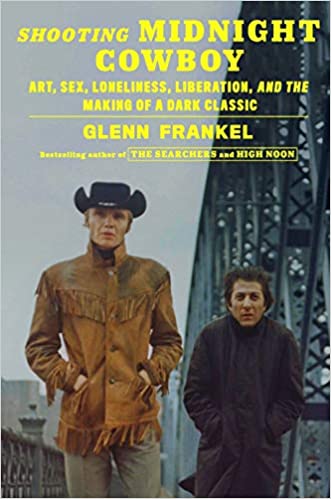 By GLENN FRANKEL (Farrar, Straus and Giroux; 2021)
By GLENN FRANKEL (Farrar, Straus and Giroux; 2021)
MIDNIGHT COWBOY (1969) is one of the greatest of the “New Hollywood” films that appeared in the late 1960s and early 70s. It’s taken 52 years, but we now have a thorough and exacting account of the film’s making and reception, courtesy of author Glenn Frankel.
…one of the greatest of the “New Hollywood” films that appeared in the late 1960s and early 70s.
MIDNIGHT COWBOY is a “Dark Classic” about a naïve southerner (Jon Voight) attempting to make it as an NYC gigolo during one of the city’s scuzziest-ever periods, with his only companion being a lowlife hustler (Dustin Hoffman). The film represented career highlights for its late director John Schlesinger, its screenwriter Waldo Salt and James Leo Herlihy, who authored the 1965 source novel.The lives and careers of all three men are covered quite voluminously by Frankel, who does the same for producer Jerome Hellman, Voight, Hoffman and every other aspect of the film, including its unforgettable theme song “Everybody’s Talkin’” by Harry Nilsson. Such a conglomeration of receptive talents is rare, as is the fact that they were allowed the latitude to create such an endearing and uncompromising piece of work.
The film represented career highlights for its late director John Schlesinger, its screenwriter Waldo Salt and James Leo Herlihy, who authored the 1965 source novel.
Several long-standing myths about MIDNIGHT COWBOY are shattered in these pages. Hoffman’s iconic taxi cab thumping, for instance, is widely claimed to have been an unscripted encounter, when in fact the scene was scripted, with Hoffman’s line (“I’m walkin’ here!”) being its only instance of improvisation. Another example: the claim that the film’s X rating was repealed after the filmmakers pressured the MPAA, when in fact the initial rating was an R, with the X having been utilized as a publicity scheme.
Several long-standing myths about MIDNIGHT COWBOY are shattered in these pages.
Controversy was something United Artists had to drum up, as the details of MIDNIGHT COWBOY’S shoot, as recounted here, were pretty uneventful. Outside the chronically insecure Schlesinger’s habitual apprehension and the elaborate security measures demanded by Hoffman (a huge star due to THE GRADUATE), the filming, in contrast to many New York set productions of the era, was relatively conflict-free. Likewise the reception, which was largely positive, and culminated with a most unexpected Best Picture Oscar win.
Also covered are the details of what happened to MIDNIGHT COWBOY’S principal players in the decades since the film’s release. Schlesinger spent years attempting to surpass the film but never quite managed to do so, while the once ultra-liberal Voight became a rabid right winger and Hoffman an acting legend (until the late 2010s, when he was accused of sexual improprieties by several women), even though not too many of his movies have had the impact of MIDNIGHT COWBOY. It’s a film that was and remains sui generis, and this book gives a good accounting of precisely why that is.
